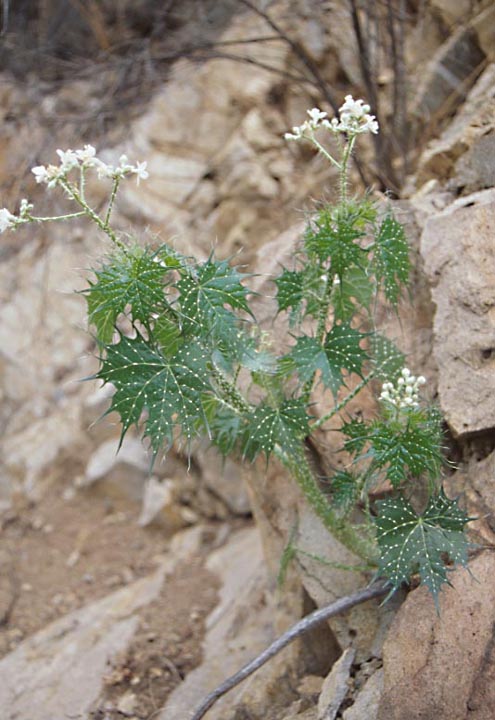Cnidoscolus
|
Family: Euphorbiaceae |
PLANTS: Herbs, shrubs, or trees, monoecious, with milky latex, armed with stinging hairs. LEAVES: alternate, simple, palmately veined and often palmately deeply lobed, stipulate; petioles glandular at the junction with the blade. INFLORESCENCE: terminal cymes. STAMINATE FLOWERS: toward the outside of the cyme; calyx 5-lobed, petal-like, white; petals 0; disk ring-shaped; stamens 8-10 in two whorls, the outer free and the inner connate or all connate; staminodes sometimes borne at the apex of the staminal column. PISTILLATE FLOWERS: toward the center of the cyme; sepals 5, separate, petal-like, white, falling soon after flowering; petals 0; disk ring-shaped, sometimes with staminodes; pistil with 3 carpels, the ovary 3-locular, the styles branching dichotomously several times. FRUIT: a capsule with 3 locules, each segment splitting and falling from the persistent columella. SEEDS: 1 per carpel, carunculate. NOTES: Ca. 50 spp. of subtropical and tropical Amer. (Greek: Cnide = nettle + skolos = thorn, in reference to the stinging hairs). REFERENCES: Levin, Geoffrey A. Euphorbiaceae. Part 1. Acalypha and Cnidoscolus. J. Ariz. - Nev. Acad. Sci. 29(1): 18. Monoecious; pet none; staminate cal gamosepalous, petaloid, white, with 5 imbricate lobes; disk annular, extrastaminal; stamens 8-10+, at least the inner connate below; pistillate cal small and caducous; ovary trilocular; styles several times bifid or laciniate; seeds 3, carunculate; herbs or woody plants with septate pith and milky juice, armed with stinging hairs; lvs simple, alternate, coarsely toothed or lobed; fls in terminal cymes, the staminate above the few pistillate ones. 50, New World. Gleason, Henry A. & Cronquist, Arthur J. 1991. Manual of vascular plants of northeastern United States and adjacent Canada. lxxv + 910 pp. ©The New York Botanical Garden. All rights reserved. Used by permission. |

